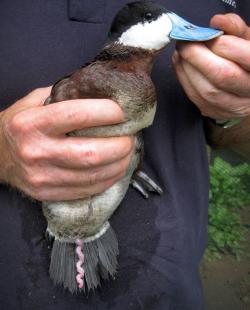So, a duck penis and an ice bucket walk into the bar...
This might be a great start to an awful joke. Duck penises and ice challenges also provide some pretty interesting insights into how the US is investing (or, more often, not investing) in research these days.
Let's start with duck penises. Not to long ago, during all of the budget debates, some lawmakers pointed out that US taxpayers are footing the bill for some research that on the surface might sound silly. These projects have things in the title that sounds frivolous in light of the countries budget woes. In addition to
duck penis research, we are also funding research on snail sex, fly genetics and
shrimps on a treadmill.
 |
| Shrimp on a treadmill |
These things are an easy political target for lawmakers that want to reduce investment in science and have constitutes that have little science background. They even give out awards given for the most ridiculous sounding grants, the
Golden Fleece Awards.
However, in reality, these projects are anything but silly. Instead, they are great examples of basic research. In this case, basic does mean remedial or simple, quite the opposite really, it just means that it is not specifically designed to solve a practical problem. Instead, it is geared towards trying understanding our crazy world, period.
 |
| Duck penis |
Just because basic research is not designed to "cure cancer" doesn't mean that it is silly or useless. Basic research is the foundation that all applied science, medical research and technological advances are based on. Cut off basic research and you cut the legs off innovation and progress. To be fair, we scientist aren't very good at teaching the public about this. Just look at the comments below the popular articles about these studies (like
here,
here or
here) and you'll find hundreds of people complaining about how government funding is being wasted on silly research.We need to get better about talking to the public about our science, and fast.
The truth is, there is no telling where the next big advancement will come from. Two examples. There are some weird jellyfish that glow green.
 |
| Art done with glowing bacteria. Seriously. |
Biologist thought this was interesting and started trying to understand how it works. What they found led to a Nobel prize. The protein responsible for glowing is now used for all kinds of research and plays a critical role in research on heart disease. Thanks weird jellyfish! Example 2: a group of biologist studying coral figured out that it is an ideal material for bone grafts, better than anything else we know of. Neither of these research groups set out to solve major human health problems; both lines of research started off as basic research that might look silly to the average tax payer. But the outcomes are anything but, as I imagine the families that are benefiting from this work would be happy to tell you. Both projects nominated for the 2014
Golden Goose Awards, which recognize major breakthroughs from federal research grants.
What does any of this have to do with the ice bucket challenge? It all comes back to research funding. The US is facing some serious decisions about where to allocate limited money, and lawmakers recently decided that research doesn't need so much money. Budgets for research agencies, like the National Science Foundation (NSF) and the National Institute of Health, were cut by 5%.
All the ice buckets in the world are not going to make a dent in this loss in research funds. And this is just one disease, what about the rest? There is also a huge mismatch between the
how deadly a disease is and how much money we donate towards research. And that's just in the US. The number for world-wide diseases would be even more disheartening. Plus, though cutting funding research might save money in the short-term, it is really bad for
jobs and economic growth in the long-term, so we all lose.

Ice-buckets are unlikely to have a long-term effect on ALS research and human health, but it is my hope is that these challenges due serve to shock Americans in to appreciating how important research funding is for their everyday lives, even if they could care less about glowing jellyfish and duck penises.

















